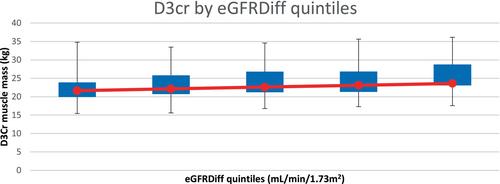Difference between kidney function by cystatin C versus creatinine and association with muscle mass and frailty
Abstract
Background
A higher difference in estimated glomerular filtration rate by cystatin C versus creatinine (eGFRDiff = eGFRCys – eGFRCreat) is associated with decreased frailty risk. Since eGFRCreat is influenced by muscle more than eGFRCys, muscle mass may explain this association. Previous work could not account for this when considering regional muscle measures by imaging. Deuterated creatine (D3Cr) dilution measures whole body muscle mass (kilograms). We aimed to determine whether eGFRDiff is associated with D3Cr muscle mass and whether muscle mass explains the association between eGFRDiff and frailty.
Methods
Cross-sectional analysis within the multicenter MrOS Study at Year 14 (visit 4). 490 men of the original cohort of 5994 MrOS participants (aged ≥65 at enrollment) were included. Exposure was eGFRDiff (= eGFRCys – eGFRCreat), calculated using CKD-EPI equations 2012/2021. Primary outcome was D3Cr muscle mass. Secondary outcome was phenotypic pre-frailty (one or two criteria) and frailty (≥three criteria) including the following: weight loss, weakness, slow gait, physical activity, poor energy. The association of eGFRDiff with D3Cr muscle mass was examined by linear regression, that with prefrailty / frailty by multinomial logistic regression.
Results
Mean ± SD age was 84 ± 4 years, eGFRCreat 68 ± 16, eGFRCys 52 ± 16, eGFRDiff −15 ± 12 mL/min/1.73 m2 and D3Cr muscle mass 24 ± 4 kg. For each SD increment in eGFRDiff, D3Cr muscle mass was 1.4 kg higher on average, p < 0.0001 (fully adjusted). Higher eGFRDiff was associated with lower odds of frailty (OR = 0.63 95% CI [0.45;0.89]), but this was partially attenuated and insignificant after additionally adjusting for D3Cr muscle mass (OR = 0.85 95% CI [0.58; 1.24]).
Conclusions
Higher eGFRDiff is associated with lower odds of frailty among late-life men. D3Cr muscle mass accounts for some of this association. This suggests that non-GFR determinants of creatinine and cystatin C, such as muscle mass, play a role in explaining the association of eGFRDiff with frailty. Future studies are needed to confirm.


 求助内容:
求助内容: 应助结果提醒方式:
应助结果提醒方式:


